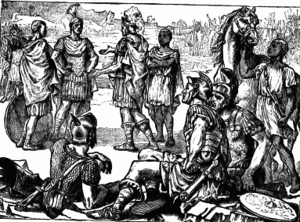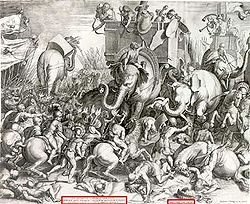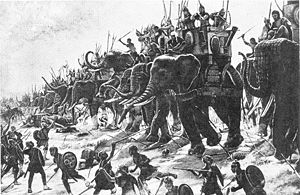Battle of Zama
|
||||||||||||||||||||||||||||||
|
||||||||||||||||||||||||||||||
The Battle of Zama, fought around October 19, 202 BC, marked the final and decisive end of the Second Punic War. A Roman army led by Publius Cornelius Scipio Africanus defeated a Carthaginian force led by the legendary commander Hannibal. Soon after this defeat on their home ground, the Carthaginian senate sued for peace, which was given to them by Roman Republic on rather humiliating terms, ending the 17-year war.
Contents |
Prelude
Hannibal reached the Italian peninsula in 218 B.C and won several major victories against the Roman armies. He was still in Italy, although confined to the south of the peninsula, when Scipio landed in Africa in 203 B.C.[2]
Following his decisive victory in Spain at the Battle of Ilipa in 206 B.C, Scipio secured Iberia for the Romans, breaking the Carthaginian power in the peninsula forever, and thereby denying any further land invasions into Italy by the Carthaginians. In 205 B.C Scipio returned to Rome where he was elected consul with a unanimous vote. Scipio now powerful enough, proposed to end the war by directly invading the Carthaginian home land.[3]
The Senate initially opposed this ambitious design of Scipio but later ratified it and Scipio was given the requisite authority to attempt the invasion.[4] Initially he received no levy troops, and he sailed to Sicily with a group of 7,000 heterogeneous volunteers[5]. Later, he obtained the authorization to employ also the regulars stationed in Sicily, which consisted mainly of the remnants of the 5th and 6th Legion, exiled to the island as a punishment for the humiliation they suffered in the Battle of Cannae.[6].
Scipio kept on reinforcing his troops with local defectors.[7] He landed at Utica, and defeated the Carthaginian army at the Battle of the Great Plains in 203 B.C. The panicked Carthaginians felt that they had no other alternative than to offer peace to Scipio, who, having the authority, granted it with modest terms. According to the terms of the treaty signed between Scipio and Carthage, Carthage could keep its African territory, but would lose its overseas empire, a fait-accompli. Masinissa was to be allowed to expand Numidia into parts of Africa. Also, Carthage was to reduce its fleet and pay a war indemnity. The Roman senate had ratified the agreement. The Carthaginian senate recalled Hannibal from Italy in 203 B.C. Meanwhile the Carthaginians breached the armistice agreement by capturing a stranded Roman fleet in the Gulf of Tunis and stripping it of supplies. The Carthaginians no longer believed a treaty advantageous, and rebuffed it under much Roman protest.[8]
Troop deployment
Hannibal led an army composed of local citizens and veterans from his Italian campaigns and Scipio was leading the already present Roman army of legionaries, along with a body of Numidian cavalry. The battle took place at Zama Minor, near Siliana 130 km south-west of the capital Tunis. Hannibal was first to march and reach the plains of Zama minor, which were suitable for cavalry maneuvering. This also gave an upper edge in turn to Scipio who relied heavily on his Roman heavy cavalry and Numidian light cavalry. Hannibal deployed his troops facing northwest, while Scipio deployed his troops in front of the Carthaginian army facing southeast.[9]
Hannibal's army consisted of 45,000 infantry, 6,000 cavalry, and 80 war elephants, while Scipio had a total of 34,000 infantry and 6,000 cavalry.[1] Putting his experienced cavalry on the flanks, Hannibal aligned his troops in three straight lines behind his eighty war elephants. The first line consisted of mixed infantry of mercenaries from Gaul, Liguria, and Baleria. In his second line he placed the Carthaginian and Libyan citizen levies, while his veterans from Italy were placed in the third line.[10] Hannibal intentionally held back his third infantry line, in order to thwart Scipio's tendency to pin the Carthaginian center and envelop his opponent's lines, as he had previously done at the Battle of Ilipa.[11] Livy states that Hannibal deployed 4000 Macedonians in the second line which is normally rejected as Roman propaganda though T Dorey suggested that there might have been a seed of truth in the story if the Carthaginians had recruited a trivial number of mercenaries from Macedonia who had gone without official blessing[12].
Scipio deployed his army in three lines: the first line was composed of the hastati, the second line of principes and the third line of the triarii. The stronger right wing was composed of the Numidian cavalry and commanded by Masinissa while the left wing was composed of the Italian cavalry under the command of Laelius. The greatest concern for Scipio was the elephants. He came up with an ingenious plan to take care of them.

Scipio knew that elephants could be ordered to charge forward, but they could only continue their charge in a straight line.[13] Scipio predicted that intentionally opening gaps in his troops would result in the elephants simply continuing between them, without harming any of his soldiers. Scipio created the lanes between the army regiments across the depth of his troops and hid them with maniples of skirmishers. The plan was that when the elephants charged these lanes would open for them to pass through the legionnaires ranks and would be dealt with at the rear of the army.
Hannibal and the Carthaginians had relied on cavalry superiority in previous battles (e.g. Battle of Cannae), but Scipio, recognizing the importance, held the cavalry advantage at Zama. This was due in part to his raising of a new cavalry regiment in Sicily and careful courting of Masinissa as an ally.
Hannibal probably hoped that the combination of the war elephants and the depth of the first two lines would weaken and disorganize the Roman advance. This would have allowed him to complete a victory with his reserves in the third line and overlap Scipio's lines. Though this formation was indeed well-conceived, it failed to produce a Carthaginian victory. The two men are said to have met face-to-face before the battle.
The battle
At the outset of the battle, Hannibal unleashed his elephants and skirmishers against the Roman troops in order to break the cohesion of their lines and exploit the breaches that could be opened.[14] The attack was confronted by the Roman skirmishers. In addition to this Scipio ordered the cavalry to blow loud horns to frighten the beasts which partly succeeded and several rampaging elephants turned towards the Carthaginian left wing and disordered it completely. Seizing this opportunity Masinissa led his Numidian cavalry and charged at the Carthaginian left wing, also composed of Numidian cavalry, and was unknowingly lured off the field. Meanwhile the rest of the elephants were carefully lured through the lanes and taken to the rear of the Roman army where they were dealt with. The plan of Scipio of neutralizing the threat of the elephants had worked. Scipio's troops then fell back into traditional Roman battle formation. Laelius, the commander of Roman left wing, charged against the Carthaginian right. The Carthaginian cavalry, acting on the instructions of Hannibal, allowed the Roman cavalry to chase them so as to lure them away from the battlefield so that they wouldn't attack the Carthaginian armies in the rear.[15]
Scipio now marched with his center towards the Carthaginian center which was under the direct command of Hannibal. Hannibal moved forward with only two lines and the third line of veterans was kept in reserve. After a close contest the first line of Hannibal was pushed back by the Roman hastati.[16] Hannibal ordered his second line not to allow the first line in their ranks. The bulk of them managed to escape and to position themselves on the wings of the second line on Hannibal's instructions.[2] Hannibal now charged with his second line. A furious struggle ensued and the Roman hastati were pushed back with heavy losses. Scipio reinforced the hastati with the second line principes.[17]
|
Hannibal starts the battle with his war elephants charging at Roman front. Scipio orders his cavalry to blow the loud horns to terrify the charging elephants, the panicked elephants turn at the Carthaginian left wing and disorder it. |
Roman right wing charges and routs the Carthaginian cavalry, followed by the Roman left wing routing the Carthaginian right wing. Remaining elephants are lured through the lanes and killed. |
Carthaginian cavalry routed off the field. Scipio attacks Hannibal's first and second line of infantry and routes both lines. |
Scipio and Hannibal rearrange their troops in a single line and battle remains almost stalemate until Roman cavalry returns and attacks Hannibal's infantry at the rear. |
With this reinforcement the Roman front renewed their attack and defeated Hannibal's second line. Again the second line was not allowed to merge with the third line and was forced to the wings along with the first line. Carthaginian cavalry carried out Hannibal's instructions well and there was no sign of Roman cavalry on the battlefield and once they were far enough away, they turned and attacked the Roman cavalry but were routed in the end. At this point there was a pause in the battle as both sides redeployed their troops. Scipio played for time as he redeployed his troops in a single line with the hastati in the middle and the principes in the inner wings and the triarii on the outer wings. Hannibal waited for Scipio to attack. The resulting clash was fierce and bloody, with neither side achieving local superiority. However, Scipio was able to rally his men.[18] The battle finally turned into Roman favor as the Roman cavalry returned onto the battlefield and attacked the Carthaginian line from behind. The Carthaginian infantry was encircled and annihilated. Thousands of Carthaginians including Hannibal managed to escape the slaughter.[19] Hannibal experienced a major defeat that put an end to all resistance on the part of Carthage. In total, as many as 20,000 men of Hannibal’s army were killed at Zama, while 20,000 were taken as prisoners. The Romans on the other hand, suffered as few as 2,500 dead.[20]
Aftermath
Soon after Scipio's victory at Zama, the war ended, with the Carthaginian senate suing for peace. Unlike the treaty that ended the First Punic War, the terms Carthage acceded to were so punishing that it was never able to challenge Rome for supremacy of the Mediterranean again. Terms of the treaty bankrupted Carthage of any chance at military might in the future, although their economic recovery was quick because they did not have to pay an army of mercenaries to fight for them. One provision was that the Carthaginians were not allowed to make war without Roman consent. This allowed the Romans to establish a casus belli for the Third Punic War when the Carthaginians defended themselves from Numidian encroachments which the Romans would not stop.

When Rome waged a Third Punic War on Carthage 70 years later, the Carthaginians had little power, and could not even defeat Masinissa in Africa. They could, however, organize a defense of their home city, which, after an extended siege, was captured and completely destroyed. Only 55,000 survived.[21]
See also
- Second Punic War
- Roman Republic
- Conquests of Hannibal
Notes
- ↑ 1.0 1.1 1.2 Davis, Paul K. (2001), 100 Decisive Battles: From Ancient Times to the Present, Oxford University Press, p. 47, ISBN 0195143663:
- "Roman: 34,000 infantry and 9,000 cavalry. Commander: Publius Cornelius Scipio.
- Carthaginian: 45,000 infantry and 3,000 cavalry. Commander: Hannibal Barca."
- ↑ 2.0 2.1 Readings in Ancient History - Illustrative Extracts from the Sources, By William Stearns Davis ISBN 1-4067-4833-1 pg:79
- ↑ Livy, 28.40
- ↑ Nigel Bagnall, The Punic Wars, p. 270.
- ↑ Liddell Hart, Scipio, p. 96.
- ↑ Liddell Hart, Scipio, p. 119.
- ↑ Nigel Bagnall, The Punic Wars, p. 271.
- ↑ History of the Art of War: Warfare in antiquity, By Hans Delbrück, ISBN 0-8032-9199-X pg:393
- ↑ The battle of Zama, By Don Nardo ISBN 1-56006-420-X pg: 30
- ↑ ...novissimos Italicos constituit, quorum et timebat fidem et segnitiam verebatur, quoniam plerosque eorum ab Italia invitos extraxerat. Frontinus, Sextus Julius: Stratagemata. English text and comments by Charles E. Bennet. Loeb classical library, 1925, page 114. ISBN 0-674-99192-3
- ↑ History of the Art of War: Warfare in antiquity, By Hans Delbrück, ISBN 0-8032-9199-X pg:393
- ↑ Macedonian Troops at the Battle of Zama, T. A. Dorey, The American Journal of Philology, Vol. 78, No. 2 (1957), pp. 185-187
- ↑ Scipio Africanus: Greater Than Napoleon, By B. H. Liddell Hart, Michael Grant, ISBN 0-306-81363-7 pg:263
- ↑ Scipio Africanus in the second Punic war, By Howard Hayes Scullard, CUP Publisher Archive, 1930
- ↑ Adrian Goldsworth, The Fall of Carthage, The Punic Wars 265-146 BC, Phoenix, 2006, page 304
- ↑ Scipio Africanus: Greater Than Napoleon, By B. H. Liddell Hart, Michael Grant, ISBN 0-306-81363-7 pg:263
- ↑ The battle of Zama, By Don Nardo ISBN 1-56006-420-X pg: 30
- ↑ Scipio Africanus: Greater Than Napoleon, By B. H. Liddell Hart, Michael Grant, ISBN 0-306-81363-7 pg:263
- ↑ History of the Art of War: Warfare in antiquity, By Hans Delbrück, ISBN 0-8032-9199-X pg:393
- ↑ Adrian Goldsworth, The Fall of Carthage, The Punic Wars 265-146 BC, Phoenix, 2006, page 305-307
- ↑ The battle of Zama, By Don Nardo ISBN 1-56006-420-X pg: 30
References
- Hans Delbrück; Warfare in Antiquity; 1920; ISBN 0-8032-9199-X
- Robert F. Pennel; Ancient Rome from the earliest times down to 476 A.D; 1890
- Theodore Ayrault Dodge; Hannibal: A History of the Art of War among the Carthaginians and Romans down to the Battle of Pydna, 168 B.C., with a Detailed Account of the Second Punic War; 1891; ISBN 0-306-81362-9
- Polybius; The general history of Polybius, Volume 2; W. Baxter for J. Parker, 1823
- Basil Liddell Hart; Scipio Africanus: Greater Than Napoleon: ; Greenhil Books, 1992, ISBN 1-85367-132-0
- In fiction, Dante's Divine Comedy, poem, Inferno XXXI.97-132, 115-124
External links
- http://www.roman-empire.net/army/zama.html
- Battle of Zama from UNRV History
- Battle of Zama animated battle map by Jonathan Webb
|
||||||||||||||||||||

